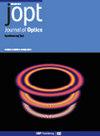Yellow light privacy protection with anti-reflection structure based on photonic band gap principle
IF 2.7
4区 物理与天体物理
Q3 OPTICS
引用次数: 0
Abstract
This paper delves into the one-dimensional photonic crystals (PCs) privacy protection structure (PPS), emphasizing a layered structure with polarization-independent angular response characteristics tailored to meet the need for PPS in various situations. Introducing a specialized design for photonic band gap (PBG), the PPS adheres to the principles of PBG. This design comprises a host structure and an anti-reflection structure carefully selected within the yellow light band (frequency range spans from 530 THz to 510 THz). The given PPS creates an angle selection (AS) window exhibiting transmittance consistently above 0.85 within −29° to 29° while ensuring transmittance drops to 0.1 within the −90° to −46° and 46°–90° range. This arrangement effectively achieves the desired PPS. The effects of the host structure on the four key parameters of refractive index and thickness of the two media on PPS properties were studied in detail. The influence of these parameters mainly involves the transmittance of the visible area, the AS, and the transmittance of the protected area.基于光子带隙原理的防反射黄光隐私保护结构
本文深入探讨了一维光子晶体(PCs)隐私保护结构(PPS),强调了一种具有偏振无关角响应特性的分层结构,可满足各种情况下的 PPS 需求。PPS 采用光子带隙(PBG)的专门设计,遵循 PBG 的原理。这种设计包括一个主结构和一个在黄光波段(频率范围从 530 太赫兹到 510 太赫兹)内精心选择的抗反射结构。给定的 PPS 创建了一个角度选择 (AS) 窗口,在 -29° 至 29° 范围内的透射率始终高于 0.85,同时确保在 -90° 至 -46° 和 46° 至 90° 范围内的透射率降至 0.1。这种安排有效地实现了所需的 PPS。我们详细研究了主结构对两种介质的折射率和厚度这四个关键参数对 PPS 性能的影响。这些参数的影响主要涉及可见光区域的透射率、AS 和保护区域的透射率。
本文章由计算机程序翻译,如有差异,请以英文原文为准。
求助全文
约1分钟内获得全文
求助全文
来源期刊

Journal of Optics
OPTICS-
CiteScore
4.50
自引率
4.80%
发文量
237
审稿时长
1.9 months
期刊介绍:
Journal of Optics publishes new experimental and theoretical research across all areas of pure and applied optics, both modern and classical. Research areas are categorised as:
Nanophotonics and plasmonics
Metamaterials and structured photonic materials
Quantum photonics
Biophotonics
Light-matter interactions
Nonlinear and ultrafast optics
Propagation, diffraction and scattering
Optical communication
Integrated optics
Photovoltaics and energy harvesting
We discourage incremental advances, purely numerical simulations without any validation, or research without a strong optics advance, e.g. computer algorithms applied to optical and imaging processes, equipment designs or material fabrication.
 求助内容:
求助内容: 应助结果提醒方式:
应助结果提醒方式:


